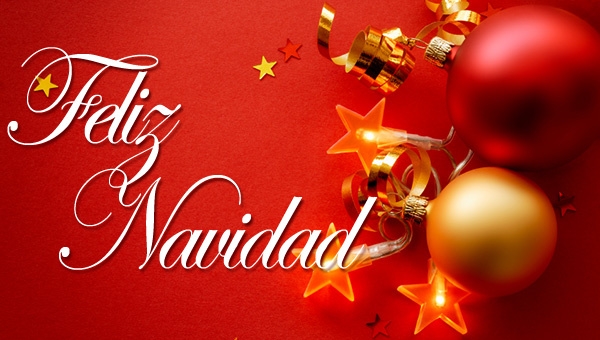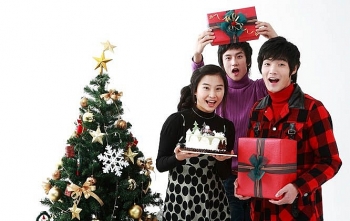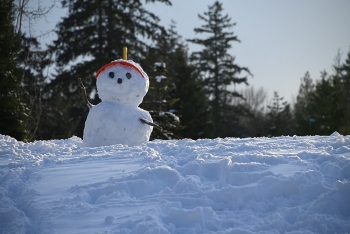Meaningful Spanish Christmas Greetings
 |
| Merry Christmas in Spanish. Photo: Spanish to English site |
It’s hard to choose a unique, heartfelt Christmas greeting for cards, letters, emails, and other holiday messages.
You want something with personality and warmth, but it’s all been done before. Well, why not try out some new Spanish Christmas greetings?
Once you’ve got some festive vocabulary under your belt, you can add to the cheer by spreading some Christmas love in español.
Traditional Spanish Christmas Greetings
The greetings you’ll see most often around the Christmas season are “¡Feliz Navidad!” (Happy Christmas) and “¡Felices Fiestas!” (Happy Holidays). There’s no being merry in Spanish around the Xmas season, it’s all about happiness.
Other new year greetings are “¡Feliz Año Nuevo!” (Happy New Year), which is often shortened to just “¡Feliz Año!” (Happy Year). Don’t get mixed up and say these greetings too soon. Save them until December 31st. Also, don’t forget that Spanish-speaking countries usually celebrate Christmas on December 24th, not the 25th. They call the evening of the 24th Nochebuena (good night).
You can also pass on your good wishes for the new year by saying something like “que tengas un próspero año” (I hope you have a prosperous new year). This might be a good one to write in a Christmas card, message or an email, and could also fit nicely in a Happy New Year tweet—though if you’re messaging your numerous followers, be sure to change tengas to tengan. If you’re not sure why we’re using the subjunctive form of the verb tener here, or aren’t sure what the subjunctive form even is, see this post.
If you want to add a little more love or affection to your Christmas messages, try something like “con mucho cariño, te deseo una Feliz Navidad“ (with all my love, I wish you a Happy Christmas) and you could tack on “y un próspero Año Nuevo“ there if you want to go all out.
Spanish Greetings for Wishing Joy and Happiness to Others
To go even further with the Xmas love, you can wish joy and happiness to those around you with the following phrases:
Mis mejores deseos para Navidad y Año Nuevo.
My best wishes for Christmas and the New Year.
Te deseo mucha alegría y felicidad estas fiestas.
I wish you lots of joy and happiness this holiday season.
Que se cumplan tus deseos/sueños.
I hope your dreams come true.
Este año te deseo amor, dinero y salud.
This year I wish you love, money, and good health.
Mucho cariño para ti y tu familia esta Navidad.
Lots of love to you and your family this Christmas.
Que lo pasen lindo.
I hope you have a nice time. (This refers to the Christmas celebrations themselves.)
Que lo pasen en familia.
I hope you spend time with your family.
You can even go further by adding a bit of peace to your message.
Que en esta Navidad el mejor regalo que recibas sea estar junto a tus seres queridos compartiendo paz, esperanza y alegría.
I hope that this Christmas the best present you get is to be near your loved ones sharing peace, hope and joy.
| You can switch these around or be more specific about spreading joy over the holidays (las fiestas), Christmas (Navidad) or New Year (Año Nuevo). So in the one about wishing that other people’s dreams come true—a very nice sentiment, I’m sure you’ll agree—you could say “Que se cumplan tus deseos estas fiestas/esta Navidad/en el Año Nuevo,” or even be more specific and simply put “en 2016.” (in 2016). You could also simply write one of the above messages, such as “Que lo pasen lindo,” and then put “¡Feliz navidad!” at the end. |
Religious Spanish Christmas Greetings
If you’d like to spread some joy of a more religious nature, try these phrases. As before, you can tack on different endings as you like.
Que Dios te bendiga este Año Nuevo.
God bless you this new year.
Que Jesús te proteja a ti y a tu familia este Año Nuevo.
May Jesus protect you and your family this New Year.
Que la estrella de Belén ilumine tu vida esta Navidad.
I hope that Bethlehem’s star lights up your life this Christmas.
Que los Reyes (Magos) te protejan.
May the three Kings (Wise Men) protect you.
Apart from the last two, which have more of a Xmas feel to them, you could use the first two phrases throughout the year, for any occasion, by just saying the first part of the phrase (Que dios te bendiga) and leaving out the New Year’s or Christmas part.
Note that in many Spanish countries, the Reyes Magos is said to visit on January 6th, so you may hear references to them, especially around this time, as the fluentu.
More Playful Spanish Christmas Greetings
If you like to spread the Xmas love by making your loved ones laugh, giggle or smile, you can try these more playful Christmas greetings. (Note that some of these may not be appropriate for the family dinner table).
Todo lo que quiero para Navidad eres tú.
All I want for Xmas is you.
Nos vemos debajo del muérdago.
See you under the mistletoe. (Be careful where you use this one! There is no mistletoe in Latin America, although some people may understand the reference through having seen Christmas movies.)
Espero que no te hayas portado mal este año.
I hope you haven’t been too naughty this year.
No le des demasiado al turrón.
Go easy on the turrón (a Spanish nougat candy).
Must-Know Christmas Day Vocabulary
1- Christmas: Navidad
This is the Spanish word for ‘Christmas’. Most happy Christmas wishes in Spanish will include this word!
2- Snow: Nieve
In most Northern-hemisphere countries, Christmas is synonymous with snow, and for Christmas, the snowman is often dressed as Santa Claus.
3- Snowflake: copo de nieve
Snowflakes collectively make up snow. A single snowflake is small, white, light like a feather and icy cold! When put under a microscope, the snowflake reveals itself to have the most beautiful, symmetrical patterns. These patterns have become popular Christmas decorations, especially in Western countries, as Spanish pod101.
4- Snowman: hombre de nieve
As you guessed – a snowman is only possible to build if it is snowing! What a fun way to spend Christmas day outside.
5- Turkey: pavo
Roast turkey is the traditional main dish on thousands of lunch tables on Christmas day, mainly in Western countries. What is your favorite Christmas dish?
6- Wreath: ramo de Navidad
Another traditional Western decoration for Christmas, the wreath is an arrangement of flowers, leaves, or stems fastened in a ring. Many families like to hang a Christmas wreath outside on their houses’ front doors.
7- Reindeer: reno
Reindeer are the animals commonly fabled to pull Santa Claus’ sled across the sky! Western Christmas folklore tells of Father Christmas or Santa Claus doing the rounds with his sled, carrying Christmas presents for children, and dropping them into houses through the chimney. But who is Santa Claus?
 |
| Photo: Country Living Magazine |
8- Santa Claus: Papá Noel
Santa Claus is a legendary and jolly figure originating in the Western Christian culture. He is known by many names, but is traditionally depicted as a rotund man wearing a red costume with a pointy hat, and sporting a long, snow-white beard!
9- Elf: elfo
An elf is a supernatural creature of folklore with pointy ears, a dainty, humanoid body and a capricious nature. Elves are said to help Santa Claus distribute presents to children over Christmas!
10- Rudolph the Red-Nosed Reindeer: Rodolfo el reno de nariz roja
‘Rudolph the Red-Nosed Reindeer’ is a Christmas song based on an American children’s story book with the same name. Rudolph is one of Santa’s reindeer. The song became more famous than the book, and can still be heard playing in many shopping malls over Christmas time across the globe!
11- North Pole: Polo Norte
The cold North Pole is where Santa Claus is reputed to live with his reindeer!
12- Sled: trineo
A sled is a non-motorised land vehicle used to travel over snow in countries where it snows a lot, and is usually pulled by animals such as horses, dogs or reindeer. This one obviously refers to Santa’s sled! Another word for sled is sleigh or sledge.
13- Present: regalo
Gift or present giving is synonymous with Christmas Eve and the greatest source of joy for children over this festive time! This tradition signifies that Christ’s birth was a gift to mankind, but not all people who hand out presents over Christmas observe the religious meaning.
14- Bell: campana
On Christmas Day, or Christmas Eve, many religious celebrants enjoy going to church for a special sermon and Christmas rituals. The start of the sermon is often announced with bells or a bell, if the church has one. For this reason, the sound of ringing bells is often associated with Christmas Day.
15- Chimney: chimenea
The chimney is the entrance Santa Claus uses to deliver children’s presents on Christmas Day, according to folklore! Wonder how the chubby man and his elves stay clean…?!
 | Learn to Say 'Merry Christmas' in French Wondering how to wish your French friends and family a Merry Christmas? Let us teach you several ways in this free French lesson. |
 | How to say Merry Christmas in Korean! Christmas has been celebrated in Korea for many years. Though this event is not widely popular, it is important to say Merry Christmas to your ... |
 | Full of tips to build your own perfect snowman on Christmas! One of the best things about winter is that it is the snowman season! What better thing to do outside after a snowstorm? If you ... |























